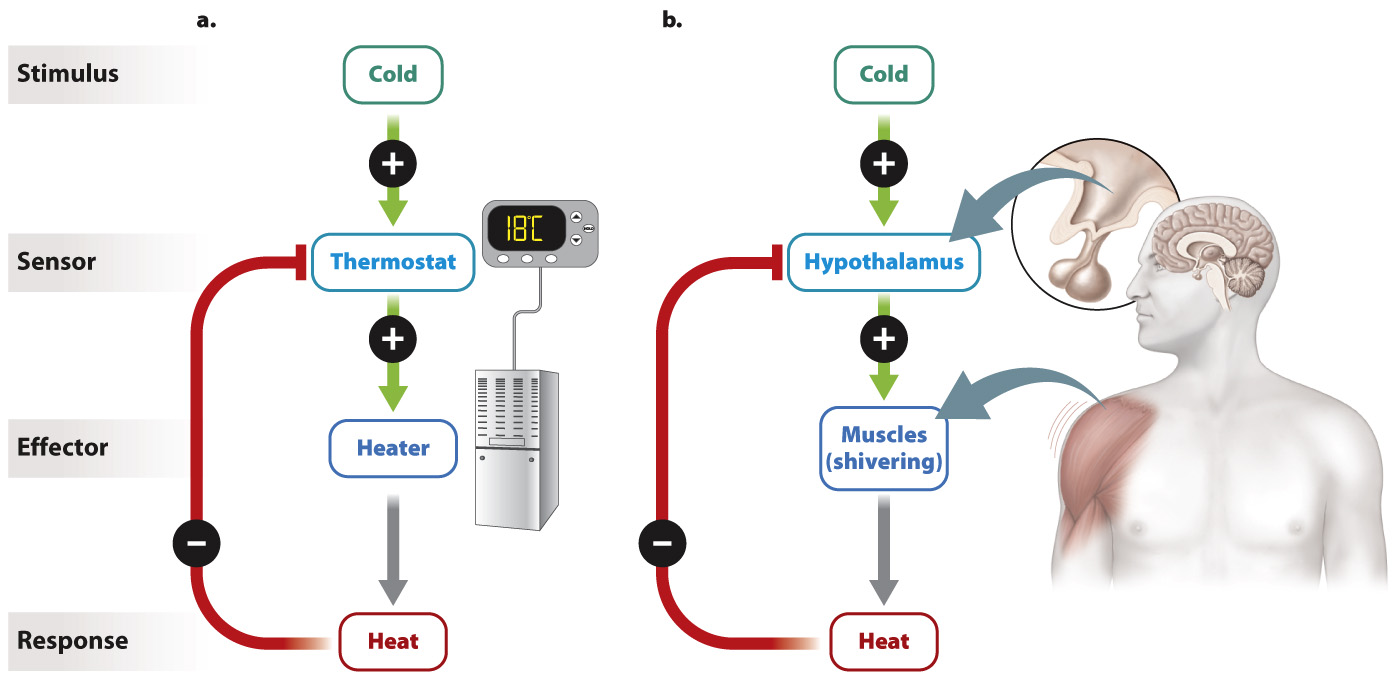The nervous system helps to maintain homeostasis.
The autonomic nervous system plays a key role in the ability to maintain homeostasis, or a steady physiological state, in the face of changing environmental conditions. In Chapter 5, we discussed how the selectively permeable cell membrane helps maintain homeostasis within individual cells. For example, it keeps ion concentrations within narrow ranges for normal cell function. Similarly, the firing of action potentials by neurons requires particular ion concentrations on either side of the membrane. Temperature and pH are other parameters that do not vary much because enzymes often work effectively only in narrow temperature and pH ranges. Recent evidence suggests that nerve cell firing rates are maintained at a steady level in the brain of rats, regardless of sensory stimulus or deprivation, or whether the animals are awake or asleep. A shift in the homeostatic set point of nerve cell firing rates may therefore underlie disorders of low brain activity, such as autism.
Homeostasis is also maintained for the whole body. Many physiological parameters are maintained in a narrow range of conditions throughout the body, including pH, temperature, and ion concentrations. Similarly, the water content of the body as a whole is kept stable through the careful regulation of ions and other solutes, as discussed in Chapter 41.
The concept of homeostasis was first described as regulation of the body’s “interior milieu” in the late 1800s by the French physiologist Claude Bernard, who is often credited with bringing the scientific method to the field of medicine. The term “homeostasis” was coined by the American physiologist Walter Cannon, whose book The Wisdom of the Body (first published in 1932) popularized the concept.
757
Maintaining steady and stable conditions takes work in the face of changing environmental conditions. That is, a cell (or organism) actively maintains homeostasis. For example, many animals are often faced with long periods of drought that challenge their ability to remain hydrated and maintain a stable water and ion balance. These animals must rapidly respond by changing the permeability of their skin and respiratory organs so that they can retain as much water as possible.
How does the body, and in particular the nervous system, maintain homeostasis? Homeostatic regulation often depends on negative feedback (Fig. 35.18). In negative feedback, a stimulus acts on a sensor that communicates with an effector, which produces a response that opposes the initial stimulus. For example, negative feedback is used to maintain a constant temperature in a house. Cool temperature (the stimulus) is detected by a thermostat (the sensor). The thermostat sends a signal to the heater (the effector), producing heat (the response). The response (heat) opposes the initial stimulus (cool temperature), and no further heat will be produced until the temperature drops below the temperature setting of the thermostat. In this way, a stable temperature is maintained (Fig. 35.18a).

In a similar way, humans and other mammals maintain a steady body temperature even as the temperature outside fluctuates. Nerve cells in the hypothalamus (located in the base of the brain) act as the body’s thermostat (Fig. 35.18b). When a decrease in the temperature in the environment causes a drop in body temperature, the lowered body temperature signals the hypothalamus to activate the somatic nervous system to induce shivering and the production of metabolic heat, as discussed in Chapter 40. At the same time, the hypothalamus activates the autonomic nervous system, causing peripheral blood vessels to constrict. The reduction in blood flow near the body’s surface reduces heat loss to the surrounding air. By contrast, an increase in temperature signals sweat glands to secrete moisture and peripheral blood vessels to dilate to aid heat loss from the skin.
Homeostatic regulation, therefore, relies on negative feedback to maintain a set point, which in this case represents an animal’s preferred body temperature. The ability to maintain a constant body temperature is known as thermoregulation, and it is just one of many physiological set points that the body actively maintains, as we discuss in subsequent chapters.